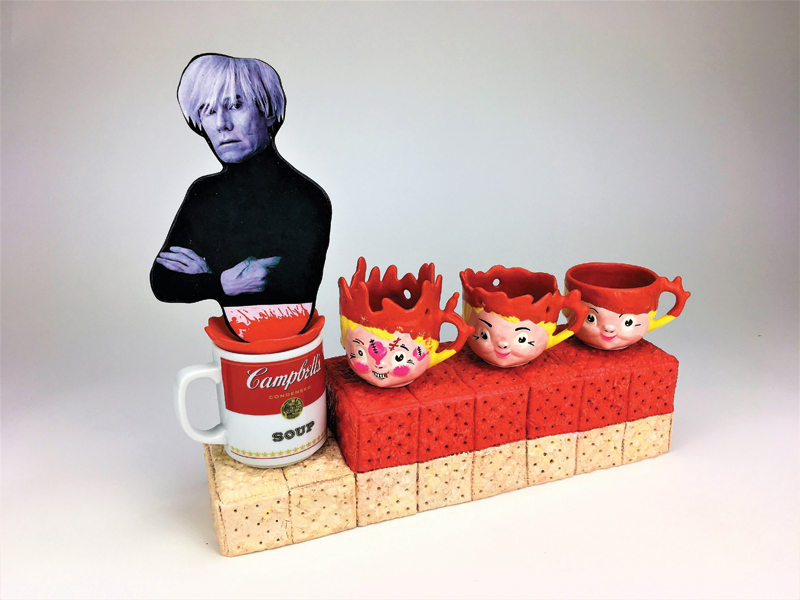Blue Collar Ornament
During his childhood in New Carlisle, OH, the father of ceramic artist Mark Burns painted the bathroom walls every two years like clockwork. Often, he chose garish colors—lively aqua and pale green—and Burn’s mother purchased cheap plaster decorations from the town’s dime store to complement the fresh paint. Burns used this anecdote to explain his funky aesthetic, redolent with allusions to his small-town roots in the Midwest. His current exhibition Blue Collar Ornament, which coincides with Burns’s position as the Koopman Distinguished Chair at the Hartford Art School, features several ceramic works showcasing this homegrown sensibility.

Mark Burns, Andy Warhol VS The Dolly Dingles, 2019, ceramic with mixed material, 14 x 4 x 15″. Photo by Mark Burns.
Working with found materials is integral to his process, said Burns, who recently discovered two knockoff versions of Hummel characters on eBay. The original porcelain figurines, based on the sentimental illustrations of a German nun, were present in many homes Burns visited as a child, so he was keen to incorporate the small plastic boy and girl into one of his piecemeal sculptures. In Hummelesque: (Ossuary and Execution) (2018), Burns has transformed the Apple Tree characters into Hansel and Gretel. The children flank the green head of the witch with a mortuary below that references an Eastern European tradition of coffins with windows in them for viewing the bodies. Built in clay and fired with a range of glazes—some most appropriate for motel ashtrays, according to Burns—the peculiar tabletop sculpture contains layers of cultural associations for viewers to unpack.
Burns’s works in the show embrace techniques and imagery that were long considered taboo within the ceramics world for their kitsch connotations. Alongside his show, Burns has also curated a baker’s dozen of ceramic artists, with whom he feels a kinship, in the stand-alone exhibition, An Impolite Aesthetic. The title of this show refers to an interview he gave when Burns was honored as a fellow to the American Craft Council in 2018. Describing his practice, he stated, “Polite people don’t make the kinds of things I make out of clay.” This statement resonates with this rowdy group of ceramists whose idiosyncratic works, like Burns’s, have never fit within the molds of pottery or stately clay sculptures.
